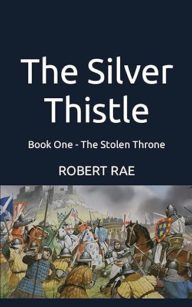
Written by: Robert Rae
Submitted By: Robert Rae
(This review submitted by the book's author)
The story is set during the Wars of Scottish Independence and follows the fictional Thomas Crauford’s quest to recover his murdered father’s coveted silver thistle brooch.
The silver thistle was given to Thomas’s father by King Alexander III for his role in alerting a camp of Scottish militia about a Norse attack. Supposedly, it was a raid of this type in the 1260’s that resulted in the thistle becoming Scotland’s national emblem, so the author borrowed the myth to set up the story. Thirty-four years later, the silver thistle is stolen in horrific circumstances and sets off a train of events that sees Thomas trying to recover the thistle and identify the man who betrayed his father.
The ‘Braveheart’ period is usually depicted in very simple, patriotic terms. It was anything but. It was a four-way standoff between France, England, Scotland and Flanders. It was politically and legally sophisticated. Scotland, like Flanders, was a pawn in a long-standing dispute between France and England that eventually evolved into the Hundred Years War. Thomas, as part of the fictional storyline, is involved in many of the important events that affected Scotland’s future, such as the Battle of the Kortrijk in which Flemish militia destroyed a French army. This crushing defeat forced the French to make peace with England and withdraw support for Scotland, leaving King Edward I free to concentrate his forces on Scotland and finally bring Scotland to its knees in 1305.
The book is a fictional story about Thomas Crauford’s adventures, but the historical background is well researched and tries to disentangle the historical context from blue dye nationalism. It is essentially a medieval adventure story that happens to follow the trail that led to Scotland regaining its independence. The core of the story is about Thomas trying to discover the identity of the mystery man at his father’s hanging. In that sense, it’s a medieval ‘Who Dunnit’.
In the book, Abbot Bernard of Kilwinning is depicted as an important character. Kilwinning was a prominent abbey at that time and an important centre of learning and ideology. The young William Wallace lived nearby so it is likely he would be familiar with the abbey’s teachings, whether or not he was taught there. Abbot Bernard went on to write the Declaration of Arbroath, which lays out Scotland’s case for recognition as an ancient sovereign nation. The declaration includes a line paraphrased from Roman times. “For as long as a hundred of us remain alive, we will never submit to English rule.” The nature and duration of the wars would suggest that those people meant it. Thomas Crauford is depicted as one of those people, and that absolute resolve has been instilled into the storyline through Thomas’s determination to recover the silver thistle. The thistle is, of course, an allegory for Scottish nationhood, taken away and then recovered after a long struggle.
Book 1 covers the period 1297-1305, the Wallace years

